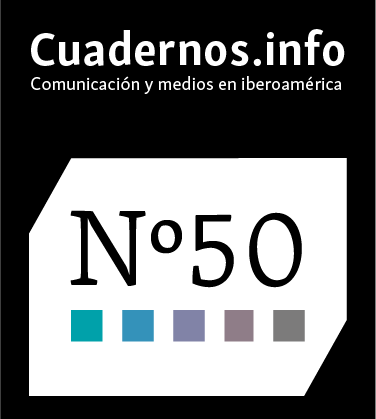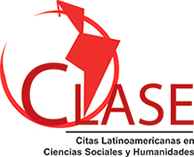El framing sobre la pandemia de Covid-19 y sus factores indicadores organizacionales
DOI:
https://doi.org/10.7764/cdi.50.37525Palabras clave:
epidemia, periodismo, comunicación de masas, comunicación de la saludResumen
La manera en la que los medios informativos encuadran la información puede influenciar las percepciones sobre los asuntos públicos de las audiencias y, por ende, el desarrollo de los debates públicos sobre los asuntos. Este efecto puede magnificarse ante crisis sanitarias como las pandemias, debido a que las personas acuden más a los medios ante asuntos desconocidos, relacionados con su seguridad y en donde coexisten múltiples perspectivas. El estudio da cuenta de los encuadres informativos de la cobertura informativa de la pandemia de Covid-19 durante la etapa de incremento de transmisión comunitaria con base en un análisis de contenido de periódicos impresos y telenoticiarios de alcance nacional en México. Los resultados muestran que en el flujo de información sobre Covid-19 predominó la atribución de responsabilidad, el interés humano y la información política, y fueron mantenidos al mínimo la información científica y la información para la autoeficacia. El análisis sugiere que el sector de medios y la orientación política fueron determinantes para construir la crisis sanitaria en los medios, así como elementos asociados a rutinas periodísticas, como las secciones y los personajes principales de las piezas informativas.
Descargas
Citas
Beaudoin, C. E. (2007). SARS news coverage and its determinants in China and the US. International Communication Gazette, 69(6), 509-524. https://doi.org/10.1177/1748048507082839
Berry, T. R., Wharf-Higgins, J., & Naylor, P. J. (2007). SARS wars: an examination of the quantity and construction of health information in the news media. Health Communication, 21(1), 35-44. https://doi.org/10.1080/10410230701283322
Bridgman, A., Merkley, E., Loewen, P. J., Owen, T., Ruths, D., Teichmann, L., & Zhilin, O. (2020). The causes and consequences of COVID-19 misperceptions: Understanding the role of news and social media. Harvard Kennedy School Misinformation Review, 1(3). Retrieved from https://misinforeview.hks.harvard.edu/article/the-causes-and-consequences-of-covid-19-misperceptions-understanding-the-role-of-news-and-social-media/
Chong, D. & Druckman, J. N. (2007). Framing theory. Annual Review of Political Science, 10, 103-126. https://doi.org/10.1146/annurev.polisci.10.072805.103054
Coleman, C. L. (1995). Science, technology and risk coverage of a community conflict. Media, Culture & Society, 17(1), 65-79. https://doi.org/10.1177%2F016344395017001005
Consumo de TV y radio en contingencia (TV and radio consumption in contingency). (2020, July 13). Nielsen Ibope. Retrieved from https://www.nielsenibope.com/2020/07/13/consumo-detv-y-radio-en-contingencia/
Dahlstrom, M. F., Dudo, A., & Brossard, D. (2012). Precision of information, sensational information, and self‐efficacy information as message‐level variables affecting risk perceptions. Risk Analysis: An International Journal, 32(1), 155-166. https://doi.org/10.1111/j.1539-6924.2011.01641.x
Dudo, A. D., Dahlstrom, M. F., & Brossard, D. (2007). Reporting a potential pandemic: A riskrelated assessment of avian influenza coverage in US newspapers. Science Communication, 28(4), 429-454. https://doi.org/10.1177%2F1075547007302211
Europa Press (2020, May 13). Investigación señala al cerebro como punto terapéutico para atender lesión pulmonar (Research points to the brain as a therapeutic point to treat lung injury). La Jornada. Retrieved from https://www.jornada.com.mx/2020/05/13/ciencias/a02nlcie?partner=rss
Gadekar, R., Krishnatray, P., & Ang, P. H. (2014). Framing of the H1N1 flu in an Indian newspaper. Journal of Creative Communications, 9(1), 49-66. https://doi.org/10.1177%2F0973258613517438
Gallagher, M. (2002, November 12-15). Women, media and democratic society: In pursuit of rights and freedoms. Paper presented at the Expert group meeting on participation and access of woman to the media, and the impact of media on, and its use as an instrument for the advancement and empowerment of women, Beirut, Lebanon. Retrieved from https://www.un.org/womenwatch/daw/egm/media2002/reports/BP1Gallagher.PDF
Garfin, D. R., Silver, R. C., & Holman, E. A. (2020). The novel coronavirus (COVID-2019) outbreak: Amplification of public health consequences by media exposure. Health Psychology, 39(5), 355-357. https://doi.org/10.1037/hea0000875
Geldsetzer, P. (2020). Knowledge and perceptions of COVID-19 among the general public in the United States and the United Kingdom: A cross-sectional online survey. Annals of Internal Medicine, 173(2), 157-160. https://doi.org/10.7326/M20-0912
Gliem, R. R. & Gliem, J. A. (2003, October 8-10). Calculating, interpreting, and reporting Cronbach’s alpha reliability coefficient for Likert-type scales. Paper presented at the Midwest researchto-practice conference in adult, continuing, and community education, Ohio State University, Columbus.
González Santos, P. & Hernández Domínguez, M. (2013). ¡Recuérdame! La obesidad infantil debatida y olvidada en los medios (Remember me! Childhood obesity debated and forgotten in the media). Revista Iberoamericana de Comunicación, 24, 45-69.
Hallin, D. C. & Mancini, P. (2004). Comparing media systems: Three models of media and politics. Cambridge University Press.
Hallin, D. C. & Papathanassopoulos, S. (2002). Political clientelism and the media: Southern Europe and Latin America in comparative perspective. Media, Culture & Society, 24(2), 175-195. https://doi.org/10.1177%2F016344370202400202
Iyengar, S. (1990). Framing responsibility for political issues: The case of poverty. Political Behavior, 12(1), 19-40. https://doi.org/10.1007/BF00992330
Kassova, L. (2020). The missing perspectives of women in COVID-19 news. Retrieved from https://www.iwmf.org/women-in-covid19-news/
Kee, C. P., Ibrahim, F., & Mustaffa, N. (2010). Framing a pandemic: analysis of Malaysian mainstream newspapers in the H1N1 coverage. Journal of Media and Information Warfare, 3, 105-122.Retrieved from https://ir.uitm.edu.my/id/eprint/46937
Krippendorf, K. (2004). Content analysis. An introduction to its methodology (2nd edition). Sage.
Lee, S. T. & Basnyat, I. (2013). From press release to news: mapping the framing of the 2009 H1N1 A influenza pandemic. Health Communication, 28(2), 119-132. https://doi.org/10.1080/10410236.2012.658550
Lee, S. & Paik, J. E. (2017). How partisan newspapers represented a pandemic: the case of the Middle East respiratory syndrome in South Korea. Asian Journal of Communication, 27(1), 82-96. https://doi.org/10.1080/01292986.2016.1235592
Luther, C. A. & Zhou, X. (2005). Within the boundaries of politics: News framing of SARS in China and the United States. Journalism & Mass Communication Quarterly, 82(4), 857-872. https://doi.org/10.1177%2F107769900508200407
Massarani, L., Buys, B., Amorim, L. H., & Veneu, F. (2005). Science Journalism in Latin America: A case study of seven newspapers in the region. Journal of Science Communication, 4(3), A02. https://doi.org/10.22323/2.04030202
Mellado, C. (2014). Professional roles in news content: Six dimensions of journalistic role performance. Journalism Studies, 16(4), 596-614. https://doi.org/10.1080/1461670X.2014.922276
Mellado, C., Márquez-Ramírez, M., Mick, J., Oller Alonso, M., & Olivera, D. (2017). Journalistic performance in Latin America: A comparative study of professional roles in news content. Journalism, 18(9), 1087-1106. https://doi.org/10.1177%2F1464884916657509
Mercado-Martinez, F. J., Robles-Silva, L., Moreno-Leal, N., & Franco-Almazan, C. (2001). Inconsistent journalism: the coverage of chronic diseases in the Mexican press. Journal of Health Communication, 6(3), 235-247. https://doi.org/10.1080/108107301752384424
Mitchelstein, E., Andelsman, V., & Boczkowski, P. J. (2019). Joanne Public vs. Joe Public: news sourcing and gender imbalance on Argentine digital media. Digital Journalism, 7(10), 1311-1327. https://doi.org/10.1080/21670811.2019.1680301
Moreno, A. (2018). El cambio electoral. Votantes, encuestas y democracia en México (The electoral change. Voters, Polls, and Democracy in Mexico). Fondo de Cultura Económica.
Muñiz, C. (2020). Media System Dependency and Change in Risk Perception During the COVID-19 Pandemic. Trípodos, 1(47), 11-26. https://doi.org/10.51698/tripodos.2020.47p11-26
Otieno, C., Spada, H., & Renkl, A. (2013). Effects of news frames on perceived risk, emotions, and learning. PLOS ONE, 8(11), e79696. https://doi.org/10.1371/journal.pone.0079696
Roche, J. P. & Muskavitch, M. A. (2003). Limited precision in print media communication of West Nile virus risks. Science Communication, 24(3), 353-365. https://doi.org/10.1177%2F1075547002250300
Rodelo, F. V. (2020). Antecedents of strategic game and issue framing of local electoral campaigns in the Mexican context. Comunicación y Sociedad, 17, 1-28. https://doi.org/10.32870/cys.v2020.7643
Rodelo, F. V. & Muñiz, C. (2017). La orientación política del periódico y su influencia en la presencia de encuadres y asuntos dentro de las noticias (The political orientation of the newspaper and its influence on the presence of frames and issues within the news). Estudios sobre el Mensaje Periodístico, 23(1), 241-256. http://doi.org/10.5209/ESMP.55594
Ross, K. & Carter, C. (2011). Women and news: A long and winding road. Media, Culture & Society, 33(8), 1148-1165. https://doi.org/10.1177%2F0163443711418272
Saldierna, A. R., Marañón, F., Prado Maillard, V. P., & Barrientos, R. (2021). Consumo de medios durante la pandemia. El caso de México (Media consumption during the pandemic. The case of Mexico). In C. Muñiz (Coord.), Medios de comunicación y pandemia de Covid-19 en México (Media and Covid-19 pandemic in Mexico) (pp. 53-79). Tirant Lo Blanch.
Sánchez Jiménez, A. (2020, May 17). Son tiempos de solidaridad, destacan investigadores. (These are times of solidarity, researches ighlight). La Jornada. Retrieved from https://www.jornada.com.mx/2020/05/17/politica/005n2pol
Sancho, V. (2020, May 13). Vidas en juego, con reapertura precipitada (Lives at stake, with hasty reopening). El Universal.
Sandell, T., Sebar, B., & Harris, N. (2013). Framing risk: communication messages in the Australian and Swedish print media surrounding the 2009 H1N1 pandemic. Scandinavian Journal of Public Health, 41(8), 860-865. https://doi.org/10.1177%2F1403494813498158
Semetko, H. A. & Valkenburg, P. M. (2000). Framing European politics: A content analysis of press and television news. Journal of Communication, 50(2), 93-109. https://doi.org/10.1111/j.1460-2466.2000.tb02843.x
Shoemaker, P. J. & Reese, S. D. (2013). Mediating the Message in the 21st century: A Media Sociology Perspective. Routledge.
Spratt, M. (2001). Science, Journalism, and the Construction of News: How Print Media Framed the 1918 Influenza Pandemic. American Journalism, 18(3), 61-79. https://doi.org/10.1080/08821127.2001.10739324
Vasterman, P. L. & Ruigrok, N. (2013). Pandemic alarm in the Dutch media: Media coverage of the 2009 influenza A (H1N1) pandemic and the role of the expert sources. European Journal of Communication, 28(4), 436-453. https://doi.org/10.1177%2F0267323113486235
Descargas
Publicado
Cómo citar
Número
Sección
Licencia
Derechos de autor 2021 Frida V. Rodelo

Esta obra está bajo una licencia internacional Creative Commons Atribución-CompartirIgual 4.0.















